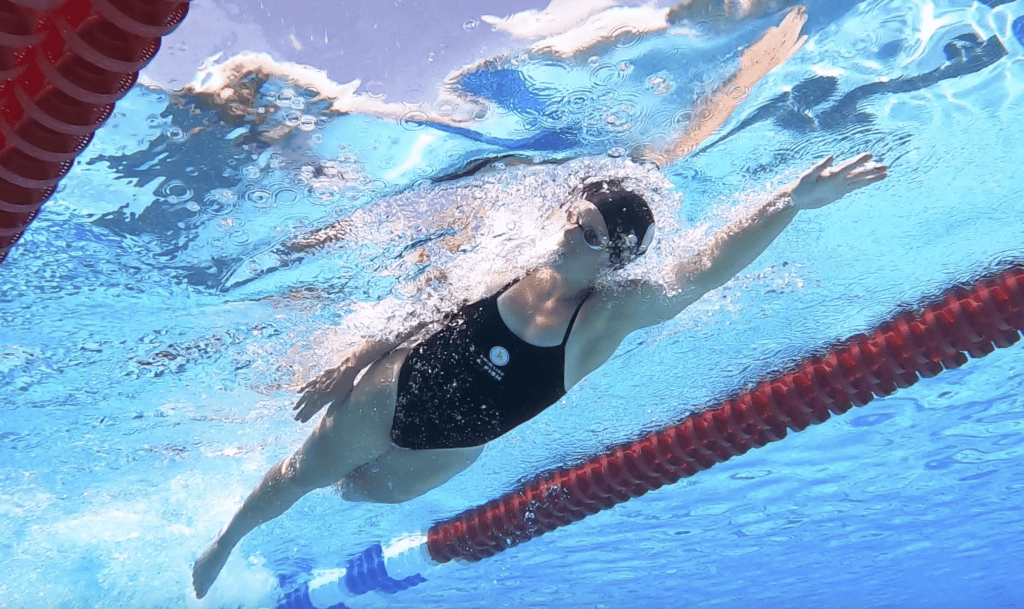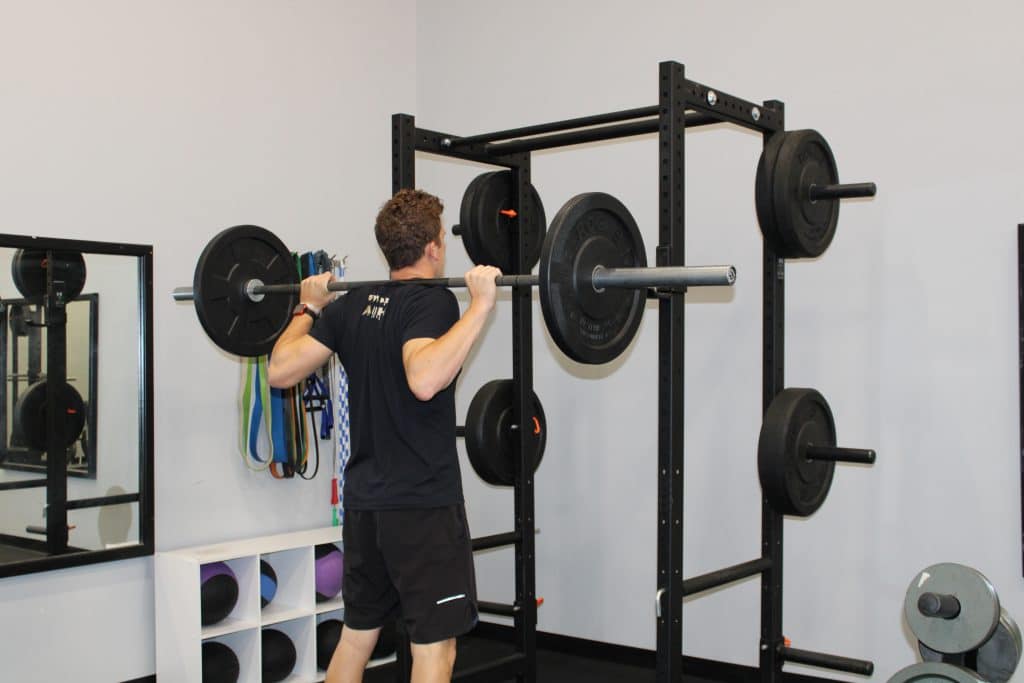A professional swimmer’s training routine goes beyond just practicing swimming technique and taking laps inside the pool. Many swimmers incorporate resistance training, such as weightlifting, into their weekly routine to help them develop strength and explosive power both in and out of the water.
Today, I am going to show you the importance and benefits of Olympic Weightlifting for swimmers and explain how to incorporate it into your weekly dryland workout regimen.
The Importance Of Dryland Training For Swimmers
Dryland training helps swimmers develop and maintain strength, power, and endurance outside of the pool. Swimmers need to be able to generate force with their arms, legs, and core in order to propel themselves through the water. Dryland exercises such as Olympic lifting can help with that.
Dryland training is important for muscle building in swimmers, as swimming is a low-impact exercise that removes the effects of gravity on our bodies, lowering training resistance.

This means that, strength-wise, we’ll get better results by exercising outside of the pool, which will then reflect in better performance inside.
Additionally, dryland exercise provides workout diversity and helps swimmers avoid training monotony, preventing training fatigue and mental exhaustion.
What Are The Olympic Weightlifting Exercises?
Just like swimming, weightlifting has been a part of the Olympic Games since the first modern edition in Athens in 1896. Currently, the two primary Olympic lifts are the Snatch and the Clean & Jerk.
Olympic lifts are compound exercises, meaning they engage multiple muscle groups and joints at once. Both the Snatch and the Clean & Jerk engage the legs, back, core, shoulders, and arms all at once.
Apart from providing a full-body exercise in one, Olympic lifts also improve explosiveness, speed, and coordination, making them a valuable addition to any swimmer’s training regimen.
Should Swimmers Practice Olympic Lifting?
Swimmers who want to improve power and explosiveness will benefit from incorporating Olympic weightlifting into their training program. That said, swimmers need to focus on the functionality of these exercises rather than their strength-building capabilities. This means avoiding high weight capacity – which can lead to muscle fatigue and injury – in favor of cleaner, faster, and more precise movements with more repetition.

On a weekly basis, you should set aside two or three days for resistance training, depending on your overall athletic level.
Four-time Olympic Gold medalist swimmer Ryan Murphy does Olympic lift variations as part of his training routine, as do the vast majority of high-level swimmers. In an interview with Men’s Health, the first exercise he recommended was the rhythm Clean & Jerk.
How To Perform Olympic Lifts For Swimmers?
As you know, swimming is a rhythmic activity in which our body performs consistent and repetitive movement patterns synchronized with our breathing.
Now, let’s take the same principle and apply it to our Olympic lifts:
- Start by using a light amount of weight; for most swimmers, just the barbell itself will be enough to feel resistance.
- Instead of putting all your strength into one big lift, practice repeating the same lifting motion multiple times, focusing on proper technique and speed.
- Let the rhythm of your exercise come naturally – it will be different from person to person depending on their primary swimming style and breathing technique.
- As a reminder, proper breathing for weightlifting includes inhaling as your lift goes up and exhaling as it goes down.
Proper breathing and avoiding holding in your breath for too long is just as important for weightlifting as it is for swimming. Perform each exercise in three to four sets for up to three to five repetitions, depending on your athletic level. Rhythmic Olympic lifts help you exercise your core tension and release, arm explosiveness, and coordination – a perfect combination for swimmers.
How To Do The Snatch:
Here are 8 easy steps to perform the Snatch:
- Begin with the barbell on the ground in front of you, with your feet shoulder-width apart and your toes pointing slightly outward
- Squat down and grip the bar with your hands way wider than shoulder-width apart, with your palms facing down
- Slowly stand up, keeping your back straight and your shoulders directly over the bar
- As you begin to stand up, explode upwards, extending your hips, knees, and ankles in one fluid movement
- As the barbell rises, pull it as close to your body as possible, keeping your arms straight
- Once the bar reaches your hips, quickly pull your elbows up and out, flipping the bar over your head
- Drop into a squat position and catch the barbell overhead with your arms locked out
- Stand up to complete the lift
How To Do The Clean And Jerk:
Here are 9 easy steps to perform a Clean & Jerk:
- Begin with the barbell on the ground in front of you, with your feet shoulder-width apart and your toes pointing slightly outward
- Squat down and grip the bar with your hands slightly wider than shoulder-width apart, with your palms facing down
- Slowly stand up, keeping your back straight and your shoulders directly over the bar
- As you begin to stand up, explode upwards, extending your hips, knees, and ankles in one fluid movement
- As the bar reaches your hips, quickly pull your elbows up and out, flipping the bar over your shoulders
- Drop under the bar and catch it in a front squat position, with your elbows high and the bar resting on your shoulders
- Stand up and prepare to jerk the bar overhead
- Dip down slightly, then drive the bar overhead, extending your hips, knees, and ankles
- Once the bar is locked out overhead, lower it back down to the starting position to complete the lift
What Equipment Do You Need For Olympic Lifting?
If you don’t have access to a gym or simply want to equip your own workout space for practicing Olympic lifts, here’s the equipment you’ll need:
- An Oly Barbell: recognizable thanks to their standardized sizing, rotating sleeves, and knurling patterns.
- Bumper plates: weightlifting plates designed to be safely dropped without causing damage to your equipment and surroundings. A set of bumper plates will cover all your weight needs.
- Barbell collars or clamps: used to lock the weight plates in place on the barbell and prevent them from moving during exercising. A pair often comes with a barbell purchase, but they’re also inexpensive to buy separately.
- Adequate lifting shoes: there are shoes specifically designed for weightlifting, as they can withstand tremendous amounts of weight. However, since we’re focusing on form over strength, a pair of quality cross-training shoes will do the trick.
Additionally, we recommend finding adequate flooring that won’t break from potential weight drops. Rubber flooring tiles, such as those seen at gyms and training facilities, are the best solution, as they’re affordable and get the job done well.
Finally, although not necessary for performing Olympic lifts, a squat or power rack is a good place for storing your barbell when you’re not using it, and it’s useful for other exercises such as overhead presses or squats.
Summary of Olympic Weight Lifting for Swimmers
For professional swimmers, dryland exercising is just as important as practicing in water. Olympic weightlifting is an excellent addition to any dryland exercise routine, as it helps with developing strength, explosiveness, speed, and coordination. Just like in swimming, it’s important to focus on proper lifting form and breathing technique.
If you need help developing your strength and conditioning workout, our expert team at Swim Like A. Fish has you covered – regardless of if you’re an individual swimmer, coach, or swim team. SLAF currently offers custom dryland training programs full of swim-specific exercises, tailored to your goals.
Do you exercise besides swimming practice? Do you perform resistance training on a weekly basis?
Let me know in the comments!
Until next time,
Keep on swimming

3 Responses
AS A SWIM SCHOOL OWNER I WANT TO REACH OUT TO DIVERSITY GROUPS AND GIVE, A FULL TALK ON HOW IMPORTANT SAFETY IN SWIMMING NEEDS TO BE ADRESSED
SINCERELY COACH JOHNSON 818_984_7182
Where are you giving this talk?
Excellent